Experiencing the pivot: building a virtual internship program (Part I)
05 November 2020 – Adina Langer
Editor’s Note: This post is the first in a series of three describing the experiences of staff and interns participating in a new virtual internship program at the Museum of History and Holocaust Education (MHHE) at Kennesaw State University, created as a response to the COVID-19 pandemic. The content of this post is based on responses to questions posed by MHHE curator Adina Langer to MHHE education program coordinator, accessibility specialist, and internship coordinator Tyler Crafton-Karnes.
Part I
In March 2020, the Museum of History and Holocaust Education (MHHE), located in Kennesaw, Georgia, had two student interns in the midst of on-site projects, including staff interviews, developing tours of museum exhibits, assisting with curatorial research, creating educational programs, and translating exhibits from English to other languages.
The pivot to virtual came quickly but relatively easily for MHHE internship coordinator Tyler Crafton-Karnes. He said, “I had to scrap certain aspects of the internship, such as participation in the on-site programs, but everything else was easy to move to an online format.”

Tyler Crafton-Karnes, MHHE education specialist and internship coordinator. Photo credit: Museum of History and Holocaust Education
For the summer semester, the MHHE recruited students from Kennesaw State University, Georgia State University, and the University of Georgia. “Many of these students had internships lined up that fell through when the shutdowns began,” Crafton-Karnes said. “With so much uncertainty, it was difficult to know if museums would be open in the summer or if staff would continue working. The staff at the MHHE, however, saw a unique opportunity to offer a valuable learning experience for students who lost their initial internships.”
Over the course of the summer, the virtual internship program grew to a cohort of 14 students. Crafton-Karnes reflected, “We were used to a maximum of three interns per semester. But we saw a void and decided to fill it. Managing so many interns while also trying to complete my everyday work was difficult at times, but I kept remembering what a rewarding experience this was for students. It really helped to see the interns so engaged and loving the projects on which they worked. That made the challenges worth working through.”
Whether on-site or virtual, the MHHE internship program strives to create “a valuable learning experience for the students with projects that can be completed in the course of the semester. By the end of the internship, students will be able to put several completed projects on their resume.” For the new virtual internship, the MHHE staff emphasized digital skills, hoping to give the students an advantage when applying for their first museum position. They worked on topical educational modules using Adobe Spark and Nearpod, created digital exhibits using the Curatescape plug-in for Omeka, and made interpretive plans for exhibit spaces with help from a virtual tour of the museum on Seekbeak.
Crafton-Karnes learned many useful things during the pilot of the MHHE’s virtual internship program. “At the beginning of the summer semester, we had students starting every other day, so we were constantly trying to keep up and add new projects for the students. For the fall semester, I developed clear schedules for the 12 students (five of whom returned from the summer semester) with projects that give students new skills, align with their career goals, and provide meaningful experiences that will set them apart from other applicants. While we met with students in a group meeting via Zoom every Friday to go over what they completed for the week and to complete a professional development workshop, I also found that monthly one-on-one meetings with each intern to go over all their projects is incredibly helpful.”
When asked what advice he would give other employers hoping to start a digital internship program, Crafton-Karnes said, “I would tell my colleagues at other museums to contact local universities, have check-in meetings with the students each week, provide professional development workshops to help students think about their futures, and to have fun!”
To students, Crafton-Karnes advises, “Network! Network! Network! I cannot stress this enough. Oftentimes, what you know is very important, but who you know is even more important. I have my current position at the MHHE because I interned with the museum five years ago. The staff knew me and knew what I was capable of doing. Be sure to intern as much as you can and always put your best foot forward. You can never go wrong if you do that.”
Looking ahead to the future of museums, Crafton-Karnes emphasizes the importance of creating robust internship programs. “This has been the most rewarding experience of my career to date. Seeing students complete projects that they can be proud of is an amazing thing to witness. I am so proud of the students. I’ve worked with in the past. Don’t get me wrong, it can be a lot of work! I see it, however, as an investment in the future of museums. I love museums and want them all to succeed. Devoting my time to interns is one way I can ensure museums succeed in the future. I know you’ll find it rewarding too.”
~The Museum of History and Holocaust Education (MHHE) at Kennesaw State University presents public events, exhibits, and educational resources focused on World War II and the Holocaust in an effort to promote education and dialogue about the past and its significance today.
In part 2 of this series, we will hear from four students who participated in the MHHE’s summer internship program.



